Classification of Landforms for Digital Soil Mapping in Urban Areas Using LiDAR Data Derived Terrain Attributes: A Case Study from Berlin, Germany
Abstract
1. Introduction
2. Study Area
3. Material and Methods
3.1. Data Source
3.2. Extraction of Geomorphometric Parameters
3.3. Land Surface Segmentation for Image Objects Extraction
3.4. Inventory of Landforms in the Study Area
3.5. Classification of Landforms
4. Results
4.1. Landform Classification and Accuracy Assessment
4.2. Capability of Soil Mapping Based on Landforms Classification
4.3. Comparison of the LiDAR DM Based Classification of Landforms with the ASTER-DEM Based Classification
5. Discussion
6. Conclusions
Funding
Conflicts of Interest
References
- Blum, W.E.H. Soil Protection Concept of the Council of Europe and Integrated Soil Research. In Integrated Soil and Sediment Research: A Basis for Proper Protection, 1st ed.; Eijsackers, H.J.P., Hamers, T., Eds.; Springer: Berlin/Heidelberg, Germany, 1993; pp. 37–47. [Google Scholar] [CrossRef]
- De Groot, R.S.; Wilson, M.A.; Boumans, R.M.J. A Typology for the Classification, Description and Valuation of Ecosystem Functions, Goods and Services. Ecol. Econ. 2002, 41, 393–408. [Google Scholar] [CrossRef]
- Aksoy, E.; Ozsoy, G.; Dirim, S.M. Soil Mapping Approach in GIS using Landsat Satellite Imagery and DEM Data. Afr. J. Agric. Res. 2009, 4, 1295–1302. [Google Scholar]
- Mermut, A.R.; Eswaran, H. Some Major Developments in Soil Science since the Mid-1960s. Geoderma 2001, 100, 403–426. [Google Scholar] [CrossRef]
- Ziadat, F.M.; Taylor, J.C.; Brewer, T.R. Merging Landsat TM Imagery with Topographic Data to Aid Soil Mapping in the Badia Region of Jordan. J. Arid Environ. 2003, 54, 527–541. [Google Scholar] [CrossRef]
- Kringer, K.; Tusch, M.; Rutzinger, M.; Wiegand, C.; Meißel, G. Geomorphometric Analyses of LiDAR Digital Terrain Models as Input for Digital Soil Mapping. In Proceedings of the Geomorphometry 2009, Zurich, Switzerland, 31 August–2 September 2009. [Google Scholar]
- Kringer, S.K. Geomorphometric Analysis of Airborne Laserscanning data for Soil Mapping in an Alpine Valley Bottom. Master’s Thesis, Institute of Geography, University of Innsbruck, Innsbruck, Germany, 2010. [Google Scholar]
- Mohamed, M.A. Monitoring of Temporal and Spatial Changes of Land Use and Land Cover in Metropolitan Regions through Remote Sensing and GIS. Nat. Resour. 2017, 8, 353–369. [Google Scholar] [CrossRef]
- Hudson, B.D. The Soil Survey as a Paradigm-Based Science. Soil Sci. Soc. Am. J. 1992, 56, 836–841. [Google Scholar] [CrossRef]
- Moore, I.D.; Gessler, P.E.; Nielson, G.A. Soil Attribute Prediction using Terrain Analysis. Soil Sci. Soc. Am. J. 1993, 57, 443–452. [Google Scholar] [CrossRef]
- McBratney, A.; Santos, M.M.; Minasny, B. On digital soil mapping. Geoderma 2003, 117, 3–52. [Google Scholar] [CrossRef]
- Lagacherie, P.; McBratney, A.B. Spatial soil information systems and spatial soil inference systems: Perspectives for digital soil mapping. In Digital Soil Mapping—An Introductory Perspectives, 1st ed.; Lagacherie, P., McBratney, A.B., Voltz, M., Eds.; Elsevier Science: Amsterdam, The Netherlands, 2007; Volume 31, pp. 3–24. [Google Scholar] [CrossRef]
- Ming, Z.; Goosens, R.; Daels, L. Application of Satellite Remote Sensing to Soil and Land Use Mapping in the Rolling Hilly Areas. Earsel Adv. Remote Sens. 1993, 2, 34–44. [Google Scholar]
- Dobos, E.; Micheli, E.; Baumgardner, M.F.; Biehl, L.; Helt, T. Use of Combined Digital Elevation Model and Satellite Radiometric Data for Regional Soil Mapping. Geoderma 2000, 97, 367–391. [Google Scholar] [CrossRef]
- Park, S.J.; McSweeney, K.; Lowery, B. Identification of the Spatial Distribution of Soils using a Process-Based Terrain Characterization. Geoderma 2001, 103, 249–272. [Google Scholar] [CrossRef]
- Florinsky, I.V.; Eilers, R.G.; Manning, G.R.; Fuller, L.G. Prediction of Soil Properties by Digital Terrain Modelling. Environ. Model. Softw. 2002, 17, 295–311. [Google Scholar] [CrossRef]
- Laborczi, A.; Szatmári, G.; Takács, K.; Pásztor, L. Mapping of topsoil texture in Hungary using classification trees. J. Maps 2016, 12, 999–1009. [Google Scholar] [CrossRef]
- Ziadat, F.M. Analyzing Digital Terrain Attributes to Predict Soil Attributes for a Relatively Large Area. Soil Sci. Soc. Am. J. 2005, 69, 1590–1599. [Google Scholar] [CrossRef]
- Valladares, G.S.; Hott, M.C. The Use of GIS and Digital Elevation Model. In Digital Soil Mapping—A Case Study from Sao Paulo, Brazil. In Digital Soil Mapping with Limited Data; Hartemink, A.E., McBratney, A., Mendonca-Santos, M.L., Eds.; Springer: Berlin/Heidelberg, Germany, 2008; pp. 349–356. [Google Scholar] [CrossRef]
- Weber, E.; Hasenack, H.; Flores, C.A.; Potter, R.O.; Fasolo, P.J. GIS as a Support to Soil Mapping in Southern Brazil. In Digital Soil Mapping with Limited Data; Hartemink, A.E., McBratney, A., Mendonca-Santos, M.L., Eds.; Springer: Berlin/Heidelberg, Germany, 2008; pp. 103–112. [Google Scholar] [CrossRef]
- Debella-Gilo, M.; Etzelmuller, B. Spatial Prediction of Soil Classes using Digital Terrain Analysis and Multinomial Logistic Regression Modeling Integrated in GIS: Examples from Vestfold County, Norway. Catena 2009, 77, 8–18. [Google Scholar] [CrossRef]
- Moura-Bueno, J.M.; Dalmolin, R.S.D.; Ten Caten, A.; Ruiz, L.F.C.; Ramos, P.V.; Dotto, A.C. Assessment of Digital Elevation Model for Digital Soil Mapping in a Watershed with Gently Undulating Topography. Rev. Bras. Ciênc. Solo 2016, 40. [Google Scholar] [CrossRef]
- Mohamed, M.A. Analysis of Digital Elevation Model and LNDSAT Data Using Geographic Information System for Soil Mapping in Urban Areas. Nat. Resour. 2017, 8, 767–787. [Google Scholar] [CrossRef]
- Guilbert, E.; Moulin, B. Towards a Common Framework for the Identification of Landforms on Terrain Models. ISPRS Int. J. Geo. Inf. 2017, 6, 12. [Google Scholar] [CrossRef]
- Zhang, B.; Fan, Z.; Du, Z.; Zehng, J.; Luo, J.; Wang, N.; Wang, Q. A Geomorphological Regionalization using the Upscaled DEM: The Beijing-Tianjin-Hebei Area, China Case Study. Sci. Rep. 2020, 10, 10532. [Google Scholar] [CrossRef]
- Bell, J.C.; Cunningham, R.L.; Havens, M.W. Soil Drainage Class Probability Mapping using a Soil-Landscape Model. Soil Sci. Soc. Am. J. 1994, 58, 464–470. [Google Scholar] [CrossRef]
- Hammer, R.D.; Young, N.C.; Wolenhaupt, T.L.; Barney, T.L.; Haithcoate, T.W. Slope Class Maps form Soil Survey and Digital Elevation Models. Soil Sci. Soc. Am. J. 1995, 59, 509–519. [Google Scholar] [CrossRef]
- Gessler, P.E.; Chadwick, O.A.; Chamran, F.; Althouse, L.; Holmes, K. Modelling Soil Landscape and Ecosystem Properties using Terrain Attributes. Soil Sci. Soc. Am. J. 2000, 64, 2046–2056. [Google Scholar] [CrossRef]
- Dobos, E.; Montanarella, L.; Negre, T.; Erika Micheli, E. A Regional Scale Soil Mapping Approach using Integrated AVHRR and DEM Data. Int. J. Appl. Earth Obs. Geoinf. 2001, 3, 30–42. [Google Scholar] [CrossRef]
- Žížala, D.; Zádorová, T.; Kapička, J. Assessment of Soil Degradation by Erosion Based on Analysis of Soil Properties Using Aerial Hyperspectral Images and Ancillary Data, Czech Republic. Remote Sens. 2017, 9, 28. [Google Scholar] [CrossRef]
- Mora-Vallejo, A.; Claessens, L.; Stoorvogel, J.; Heuvelink, G.B.M. Small Scale Digital Soil Mapping in Southeastern Kenya. Catena 2008, 76, 44–53. [Google Scholar] [CrossRef]
- Piloyan, A.; Konečný, M. Semi-Automated Classification of Landform Elements in Armenia Based on SRTM DEM using K-Means Unsupervised Classification. Quaest. Geogr. 2017, 36, 94–103. [Google Scholar] [CrossRef]
- Wood, J.D. The Geomorphological Characterisation of Digital Elevation Models. Ph.D. Thesis, University of Leicester, Leicester, UK, 1996. Available online: https://leicester.figshare.com/articles/The_geomorphological_characterisation_of_Digital_Elevation_Models_/10152368 (accessed on 4 May 2019).
- Blaszczynski, J.S. Landform characterization with geographic information Systems. Photogramm. Eng. Remote Sens. 1997, 63, 183–191. [Google Scholar]
- Dikau, R. Oberflächenprozesse—Ein altes oder ein neues Thema? Geogr. Helv. 2006, 61, 170–180. [Google Scholar] [CrossRef]
- Veselský, M.; Bandura, P.; Burian, L.; Harciníková, T.; Bella, P. Semi-automated recognition of planation surfaces and other flat landforms: A case study from the Aggtelek Karst, Hungary. Open Geosci. 2015, 1, 799–811. [Google Scholar] [CrossRef]
- Irvin, B.J.; Ventura, S.J.; Slater, B.K. Fuzzy and isodata classification of landform elements from digital terrain data in Pleasant Valley, Wisconsin. Geoderma 1997, 77, 137–154. [Google Scholar] [CrossRef]
- Burrough, P.A.; van Gaans, P.F.M.; MacMillan, R.A. High-resolution landform classification using fuzzy k-means. Fuzzy Sets Syst. 2000, 113, 37–52. [Google Scholar] [CrossRef]
- Adediran, A.O.; Parcharidis, I.; Poscolieri, M.; Pavlopoulos, K. Computer-assisted discrimination of morphological units on north-central Crete (Greece) by applying multivariate statistics to local relief gradients. Geomorphology 2004, 58, 357–370. [Google Scholar] [CrossRef]
- Mokarram, M.; Seif, A.; Sathyamoorthy, D. Landform classification via fuzzy classification of morphometric parameters computed from digital elevation models: Case study on Zagros Mountains. Arab J. Geosci. 2015, 8, 4921–4937. [Google Scholar] [CrossRef]
- Szypuła, B.; Wieczorek, M. Geomorphometric relief classification with the k-median method in the Silesian Upland, southern Poland. Front. Earth Sci. 2020, 14, 152–170. [Google Scholar] [CrossRef]
- Brown, D.G.; Lusch, D.P.; Duda, K.A. Supervised classification of types of glaciated landscapes using digital elevation data. Geomorphology 1998, 21, 233–250. [Google Scholar] [CrossRef]
- Hengl, T.; Rossiter, D.G. Supervised landform classification to enhance and replace photo–interpretation in semi-detailed soil survey. Soil Sci. Soc. Am. J. 2003, 67, 1810–1822. [Google Scholar] [CrossRef]
- Prima, O.D.A.; Echigo, A.; Yokoyama, R.; Yoshida, T. Supervised landform classification of Northeast Honshu from DEM-derived thematic maps. Geomorphology 2006, 78, 373–386. [Google Scholar] [CrossRef]
- Stepinski, T.F.; Collier, M.L. Extraction of Martian valley networks from digital topography. J. Geophys. Res. 2004, 109, 1–9. [Google Scholar] [CrossRef]
- Stepinski, T.F.; Vilalta, R. Digital topography models for Martian surfaces. IEEE Geosci. Remote Sens. Lett. 2005, 2, 260–264. [Google Scholar] [CrossRef]
- Evans, I.S. General Geomorphology, derivatives of altitude and descriptive statistics. In Spatial Analysis in Geomorphology; Chorley, R.J., Ed.; Methuen & Co. Ltd.: London, UK, 1972; pp. 17–90. [Google Scholar] [CrossRef]
- Dikau, R. The Application of a Digital Relief Model to Landform Analysis in Geomorphology. In Three Dimensional Applications in Geographical Information Systems; Raper, J., Ed.; Taylor & Francis Inc.: London, UK, 1989; pp. 51–77. ISBN 0-85066-776-3. [Google Scholar]
- Dehn, M.; Gärtner, H.; Dikau, R. Principles of semantic modeling of landform structures. Comput. Geosci. 2001, 27, 1005–1010. [Google Scholar] [CrossRef]
- Crevenna, A.B.; Vicente, T.R.; Valentino, S.; Frame, D.; Ortiz, M.A. Geomorphometric analysis for characterizing landforms in Morelos State, Mexico. Geomorphology 2005, 67, 407–422. [Google Scholar] [CrossRef]
- Geological Outline (2013 Edition). Available online: https://www.stadtentwicklung.berlin.de/umwelt/umweltatlas/e_text/k117.pdf (accessed on 20 August 2018).
- Kasprzak, M.; Traczyk, A. LiDAR and 2D Electrical Resistivity Tomography as a Supplement of Geomorphological Investigations in Urban Areas: A Case Study from the City of Wrocław (SW Poland). Pure Appl. Geophys. 2014, 171, 835–855. [Google Scholar] [CrossRef]
- Bittner, T. Vagueness and the trade-off between the classification and delineation of geographic regions—An ontological analysis. Int. J. Geogr. Inf. Sci. 2011, 25, 825–850. [Google Scholar] [CrossRef]
- Drăguţ, L.; Eisank, C. Automated object-based classification of topography from SRTM data. Geomorphology 2012, 141–142, 21–33. [Google Scholar] [CrossRef]
- Elkins, D.; Elkins, T.H.; Hofmeister, B. Berlin—The Spatial Structure of a Divided City, 1st ed.; Methuen & Co. Ltd.: London, UK, 1988; pp. 75–78. [Google Scholar] [CrossRef]
- Berlin, Germany Climate Summary. Available online: http://www.weatherbase.com/weather/weather-summary.php3?s=58301&cityname=Berlin%2C+Berlin%2C+Germany&units (accessed on 20 August 2018).
- Map of Soil Associations and Soil Types (Edition 2015). Available online: https://fbinter.stadt-berlin.de/fb/index.jsp (accessed on 3 May 2019).
- Ad-hoc-Arbeitsgruppe. Bodenkundliche Kartieranleitung (KA4), 4th ed.; Bundesanstalt für Geowissenschaften und Rohstoffe und staatliche geologische Dienste in Zusammenarbeit mit den Staatlichen Geologischen Diensten der Bundesrepublik; Schweizerbart Science Publishers: Hannover, Germany, 1994; pp. 170–226. [Google Scholar]
- Ad-hoc-Arbeitsgruppe. Bodenkundliche Kartieranleitung (KA5), 5th ed.; Bundesanstalt für Geowissenschaften und Rohstoffe und staatliche geologische Dienste in Zusammenarbeit mit den Staatlichen Geologischen Diensten der Bundesrepublik; Schweizerbart Science Publishers: Hannover, Germany, 2005; pp. 197–283. [Google Scholar]
- FAO. World Reference Base for Soil Resources 2014-International Soil Classification System for Naming Soils and Creating Legends for Soil Maps; FAO: Rome, Italy, 2015; pp. 22–139. [Google Scholar]
- ATKIS® DGM—Digitales Geländemodell of Berlin. Available online: https://fbinter.stadt-berlin.de/fb/berlin/service_intern.jsp?id=a_dgm@senstadt&type=FEED (accessed on 2 January 2020).
- NASA Earthdata. Available online: https://search.earthdata.nasa.gov/search?m=34.56402318925246!29.179687500000004!3!1!0!0%2C2 (accessed on 2 January 2020).
- Li, P.; Shi, C.; Li, Z.; Muller, J.P.; Drummond, J.; Li, X.; Li, T.; Li, Y.; Liu, J. Evaluation of ASTER GDEM using GPS benchmarks and SRTM in China. Int. J. Remote Sens. 2013, 34, 1744–1771. [Google Scholar] [CrossRef]
- Fujisada, H.; Bailey, G.B.; Kelly, G.G.; Hara, S.; Abrams, M.J. ASTER DEM Performance. IEEE Trans. Geosci. Remote Sens. 2005, 43, 2707–2714. [Google Scholar] [CrossRef]
- Digital Environment Atlas of Berlin. Available online: https://www.stadtentwicklung.berlin.de/umwelt/umweltatlas/edua_index.shtml (accessed on 3 January 2020).
- Map of Soil Functions (Edition 2018). Available online: https://www.stadtentwicklung.berlin.de/umwelt/umweltatlas/eid112.htm (accessed on 3 May 2019).
- Geological Maps of Berlin (1: 10,000). Available online: https://fbinter.stadt-berlin.de/fb/berlin/service_intern.jsp?id=geokart@senstadt&type=WMS (accessed on 3 May 2019).
- Geological Maps of Berlin (1: 50,000). Available online: https://fbinter.stadt-berlin.de/fb/berlin/service_intern.jsp?id=s01_17_Geoskizze_Mai_2007@senstadt&type=WFS (accessed on 4 May 2019).
- Digital Topographic Map of Berlin (1: 25,000). Available online: https://fbinter.stadt-berlin.de/fb/berlin/service_intern.jsp?id=k_dtk25@senstadt&type=WMS (accessed on 3 May 2019).
- Digital Topographic Map of Berlin (1: 50,000). Available online: https://fbinter.stadt-berlin.de/fb/berlin/service_intern.jsp?id=k_dtk50@senstadt&type=WMS (accessed on 4 May 2019).
- Groundwater Depth Map (1: 50,000). Available online: https://www.stadtentwicklung.berlin.de/umwelt/umweltatlas/edin_207.htm (accessed on 4 May 2019).
- Digital Color Orthophotos (0.2 m). Available online: https://fbinter.stadt-berlin.de/fb/gisbroker.do;jsessionid=E85D7CF0366626FA584394A161BDB756?cmd=map_start (accessed on 5 May 2019).
- De Smith, M.J.; Goodchild, M.F.; Longley, P.A. Geospatial Analysis: A Comprehensive Guide to Principles, Techniques and Software Tools; Troubador Publishing Ltd.: London, UK, 2008. [Google Scholar]
- Zevenbergen, L.W.; Thorne, C.R. Quantitative analysis of land surface topography. Earth Surf. Process. Landf. 1987, 12, 47–56. [Google Scholar] [CrossRef]
- Wichmann, V.; Rutzinger, M.; Vetter, M. Digital Terrain Model Generation from airborne Laser Scanning Point Data and the Effect of grid-cell size on the Simulation Results of a Debris Flow Model. In SAGA Seconds Out, Hamburger Beiträge zur Physischen Geographie und Landschaftsökologie; Böhner, J., Blaschke, T., Montanarella, L., Eds.; Universität Hamburg: Hamburg, Germany, 2008; Volume 19, pp. 103–113. [Google Scholar]
- Böhner, J.; Selige, T.B. Spatial prediction of soil attributes using terrain analysis and climate regionalisation. In SAGA Analysis and Modelling Applications; Böhner, J., McCloy, K.R., Eds.; Göttinger Geographische Abhandlungen: Göttingen, Germany, 2006; Volume 115, pp. 13–27. [Google Scholar]
- Quinn, P.; Beven, K.; Chevallier, P.; Planchon, O. The prediction of hillslope flow paths for distributed hydrological modelling using digital terrain models. Hydrol. Process. 1991, 5, 59–79. [Google Scholar] [CrossRef]
- Klingseisen, B.; Metternicht, G.; Paulus, G. Geomorphometric landscape analysis using a semi-automated GIS-approach. Environ. Modell. Softw. 2008, 23, 109–121. [Google Scholar] [CrossRef]
- Burrough, P.A.; McDonnell, R.A. Principles of Geographical Information Systems, 3rd ed.; Oxford University Press: Oxford, UK, 2015; ISBN 978-0-19-874284-5. [Google Scholar]
- Lang, S. Object-based image analysis for remote sensing applications: Modeling reality—Dealing with complexity. In Object-Based Image Analysis-Spatial Concepts for Knowledge- Driven Remote Sensing Applications; Blaschke, T., Lang, S., Hay, G.J., Eds.; Springer: Berlin/Heidelberg, Germany, 2008; pp. 3–27. [Google Scholar]
- Minár, J.; Evans, I.S. Elementary forms for land surface segmentation: The theoretical basis of terrain analysis and geomorphological mapping. Geomorphology 2008, 95, 236–259. [Google Scholar] [CrossRef]
- Friedrich, K. Digitale Reliefgliederungsverfahren zur Ableitung bodenkundlich relevanter Flächeneinheiten. In Frankfurter Geowissenschaftliche Arbeiten; Fachbereich Geowissenschaften der Johann Wolfgang-Goethe-Universität Frankfurt: Frankfurt am Main, Germany, 1996; Volume 21. [Google Scholar]
- Speight, J.G. Landform. In Australian Soil and Land Survey Field Handbook, 3rd ed.; Australian Soil and Land Survey Field Handbook; CSIRO Publishing: Collingwood, Australia, 2009; pp. 15–55. [Google Scholar]
- Speight, J.G. A parametric approach to landform regions. In Progress in Geomorphology; Brown, E.H., Waters, R.S., Eds.; Alden Press: London, UK, 1974; pp. 213–230. [Google Scholar]
- Coops, N.C.; Gallant, J.C.; Loughhead, A.N.; Mackey, B.J.; Ryan, P.J.; Mullen, I.C.; Austin, M.P. Developing and Testing Procedures to Predict Topographic Position from Digital Elevation Models (DEMs) for Species Mapping (Phase 1); Client Report No. 271; Environment Australia, CSIRO Forestry and Forest Products: Canberra, Australia, 1998; p. 56. [Google Scholar]
- Hengl, T. Finding the right pixel size. Comput. Geosci. 2006, 32, 1283–1298. [Google Scholar] [CrossRef]
- James, L.A.; Watson, D.G.; Hansen, W.F. Using LiDAR data to map gullies and headwater streams under forest canopy: South Carolina, USA. Catena 2007, 71, 132–144. [Google Scholar] [CrossRef]
- Kraus, K. Determination of terrain models in wooded areas with airborne laser scanner data. ISPRS J. Photogramm. Remote Sens. 1998, 53, 193–2013. [Google Scholar] [CrossRef]
- Sato, H.P.; Yagi, H.; Koarai, M.; Iwahashi, J.; Sekiguchi, T. Airborne LIDAR Data Measurement and Landform Classification Mapping in Tomari-no-tai Landslide Area, Shirakami Mountains, Japan. In Progress in Landslide Science; Kyoji, S., Hiroshi, F., Fawu, W., Gonghui, W., Eds.; Springer: Berlin/Heidelberg, Germany, 2007; pp. 237–249. [Google Scholar]
- Saito, T.; Yamamoto, K.; Komatsu, M.; Matsuda, H.; Yunohara, S.; Komatsu, H.; Tateishi, M.; Xiang, Y.; Otsuki, K.; Kumagai, T. Using airborne LiDAR to determine total sapwood area for estimating stand transpiration in plantations. Hydrol. Process. 2015, 29, 5071–5087. [Google Scholar] [CrossRef]
- Guth, P.L. Geomorphometric comparison of ASTER GDEM and SRTM. In Proceedings of the A Special Joint Symposium of ISPRS Technical Commission IV and AutoCarto in Conjunction with ASPRS/CaGIS, Fall Specialty Conference, Orlando, FL, USA, 15–19 November 2010. [Google Scholar]
- Schneevoigt, N.J.; van der Linden, S.; Thamm, H.-P.; Schrott, L. Detecting Alpine landforms from remotely sensed imagery. A pilot study in the Bavarian Alps. Geomorphology 2008, 93, 104–119. [Google Scholar] [CrossRef]
- Van Asselen, S.; Seijmonsbergen, A. Expert-driven semi-automated geomorphological mapping for a mountainous area using a laser DTM. Geomorphology 2006, 78, 309–320. [Google Scholar] [CrossRef]
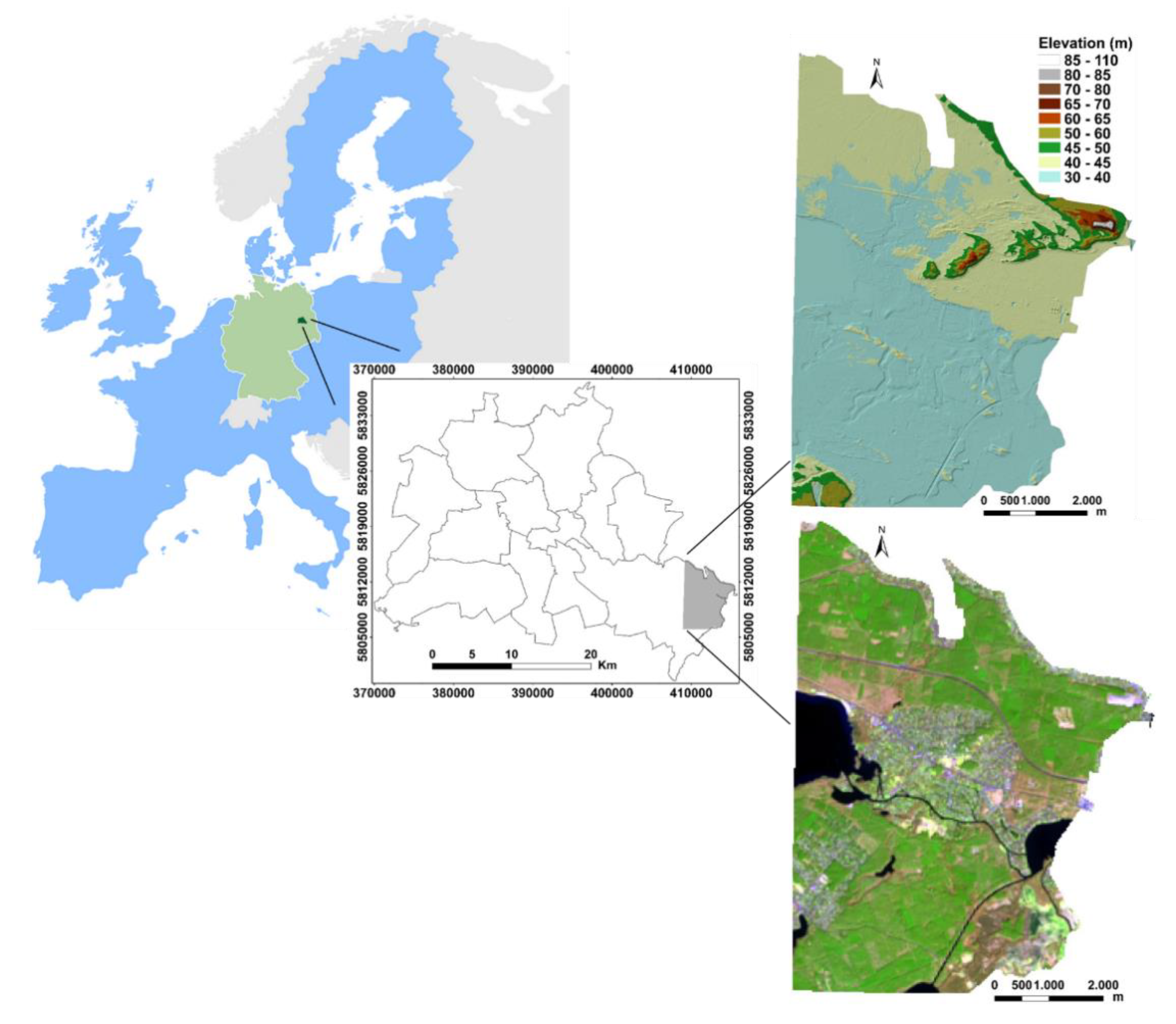
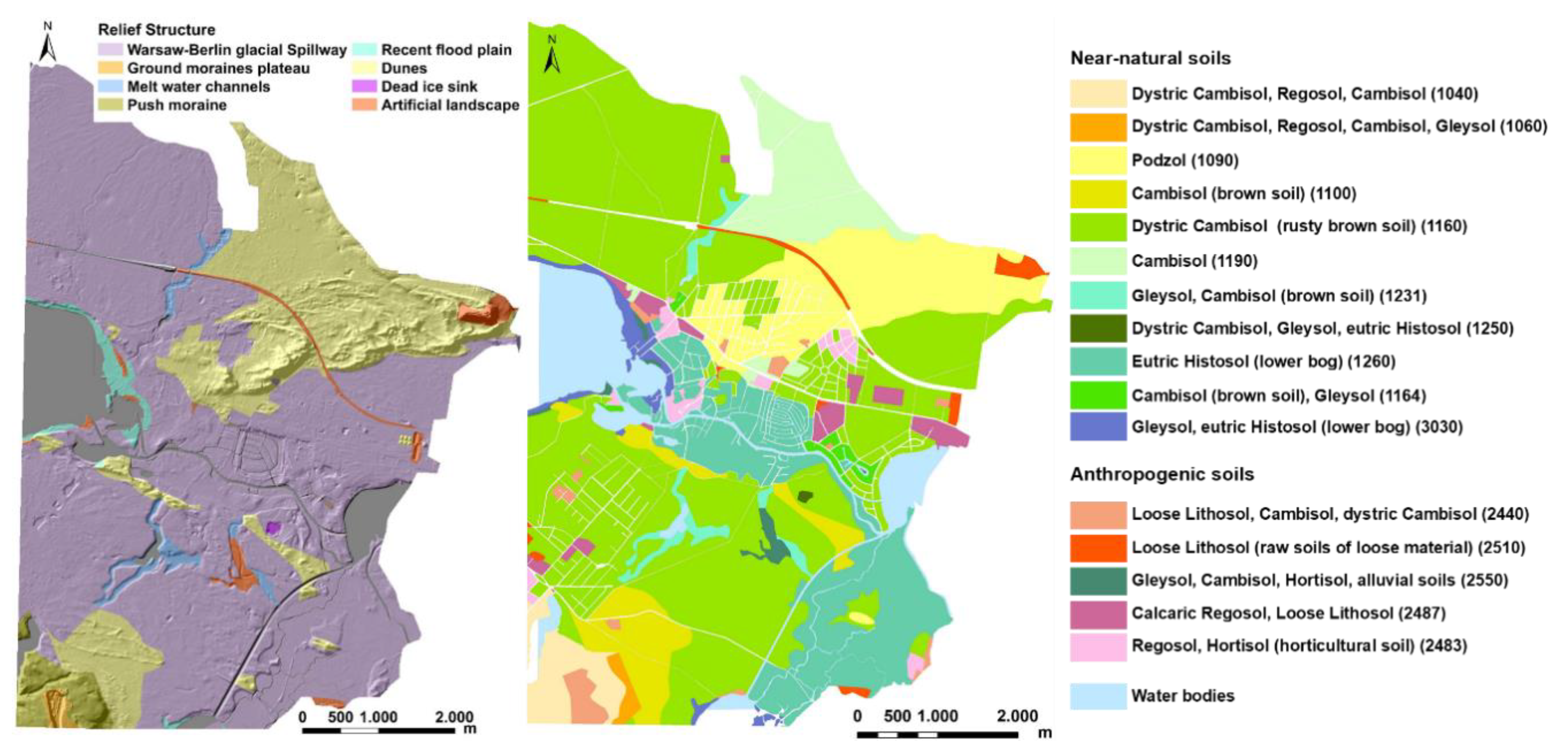
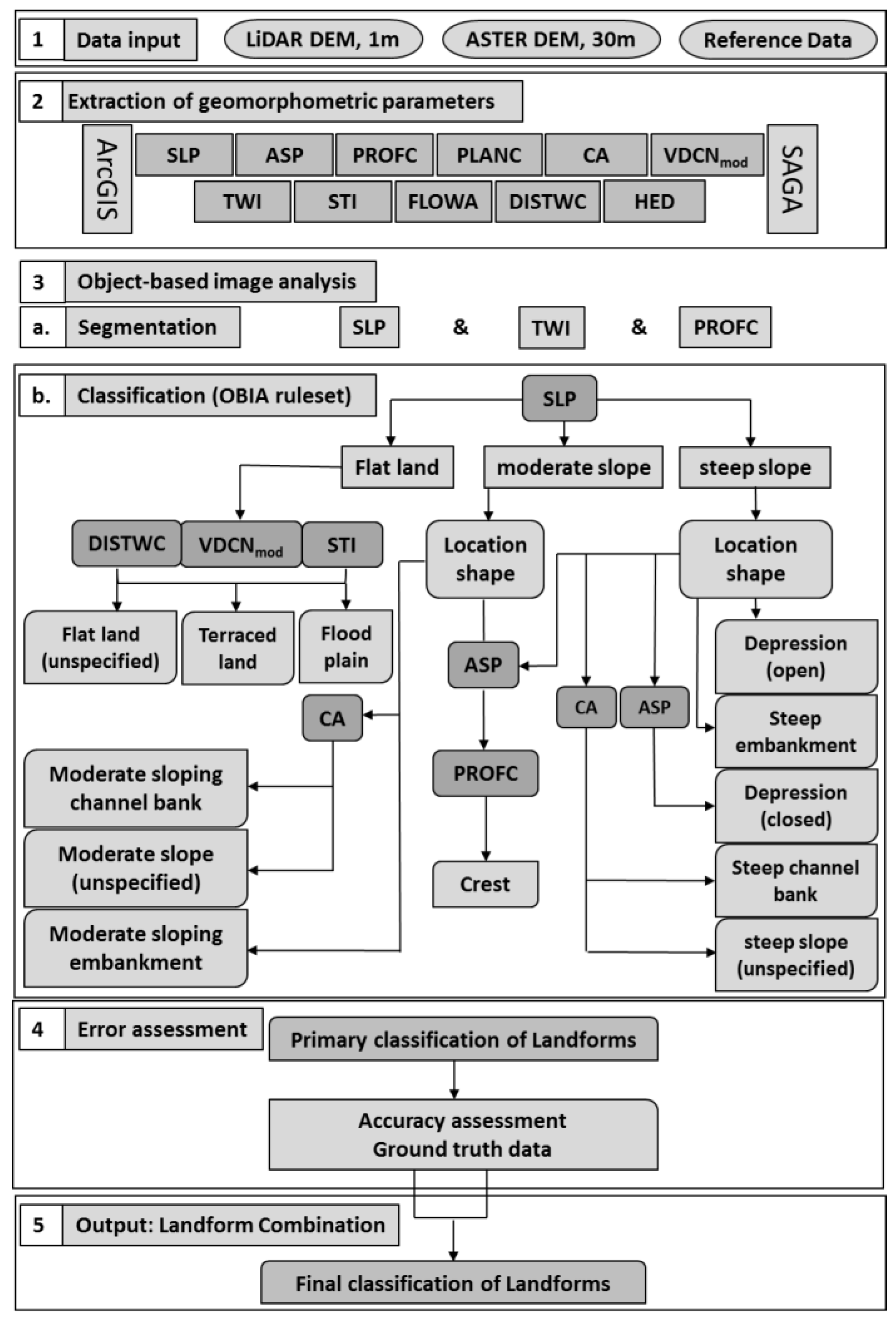
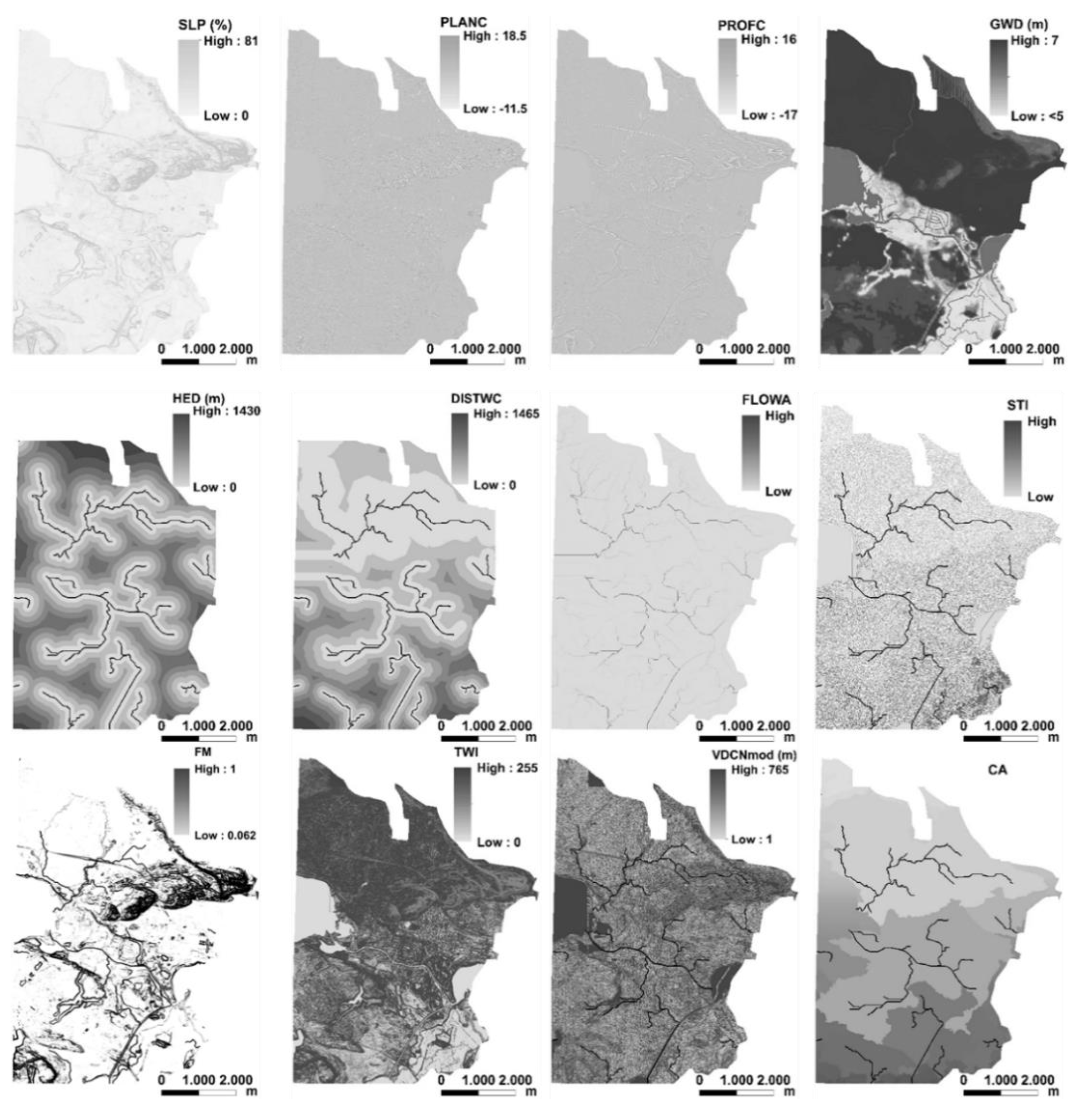
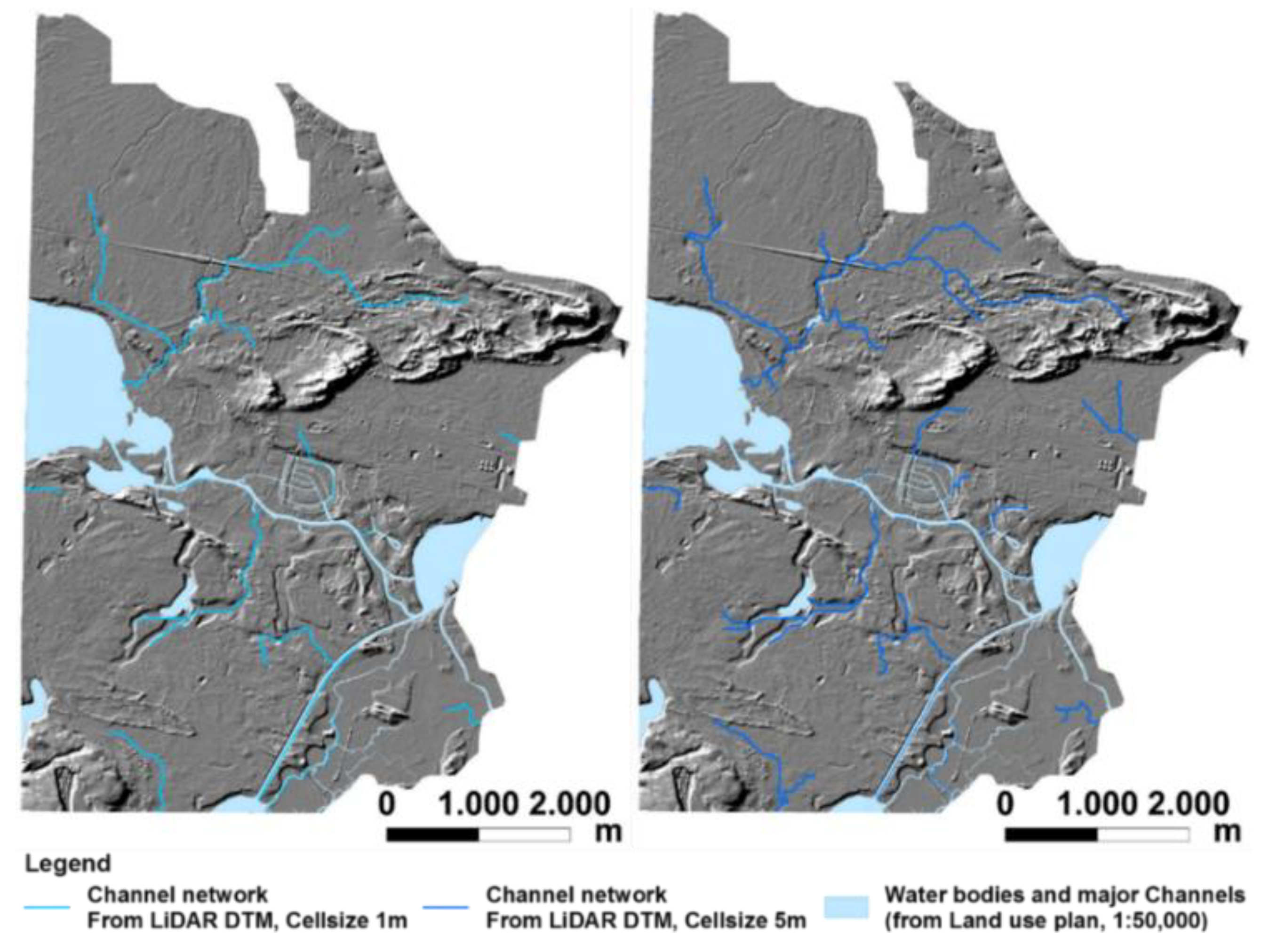


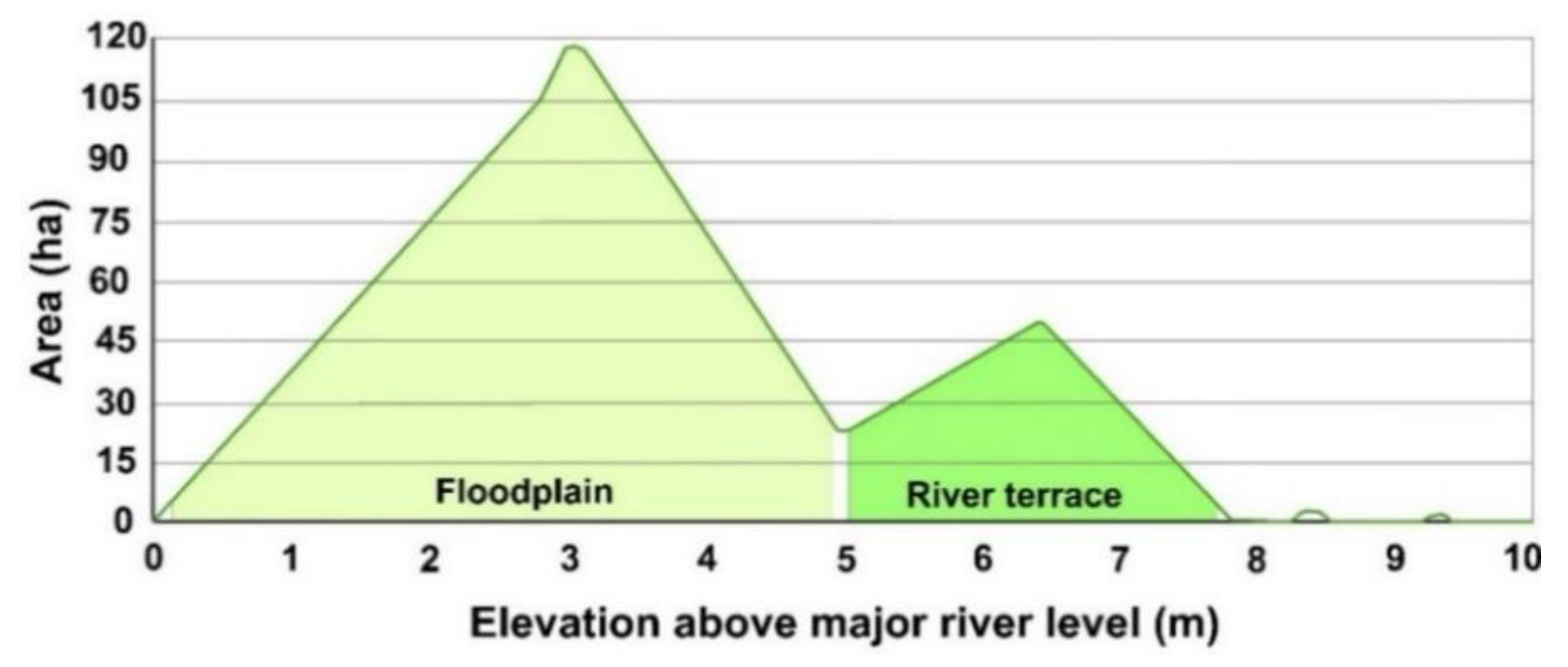

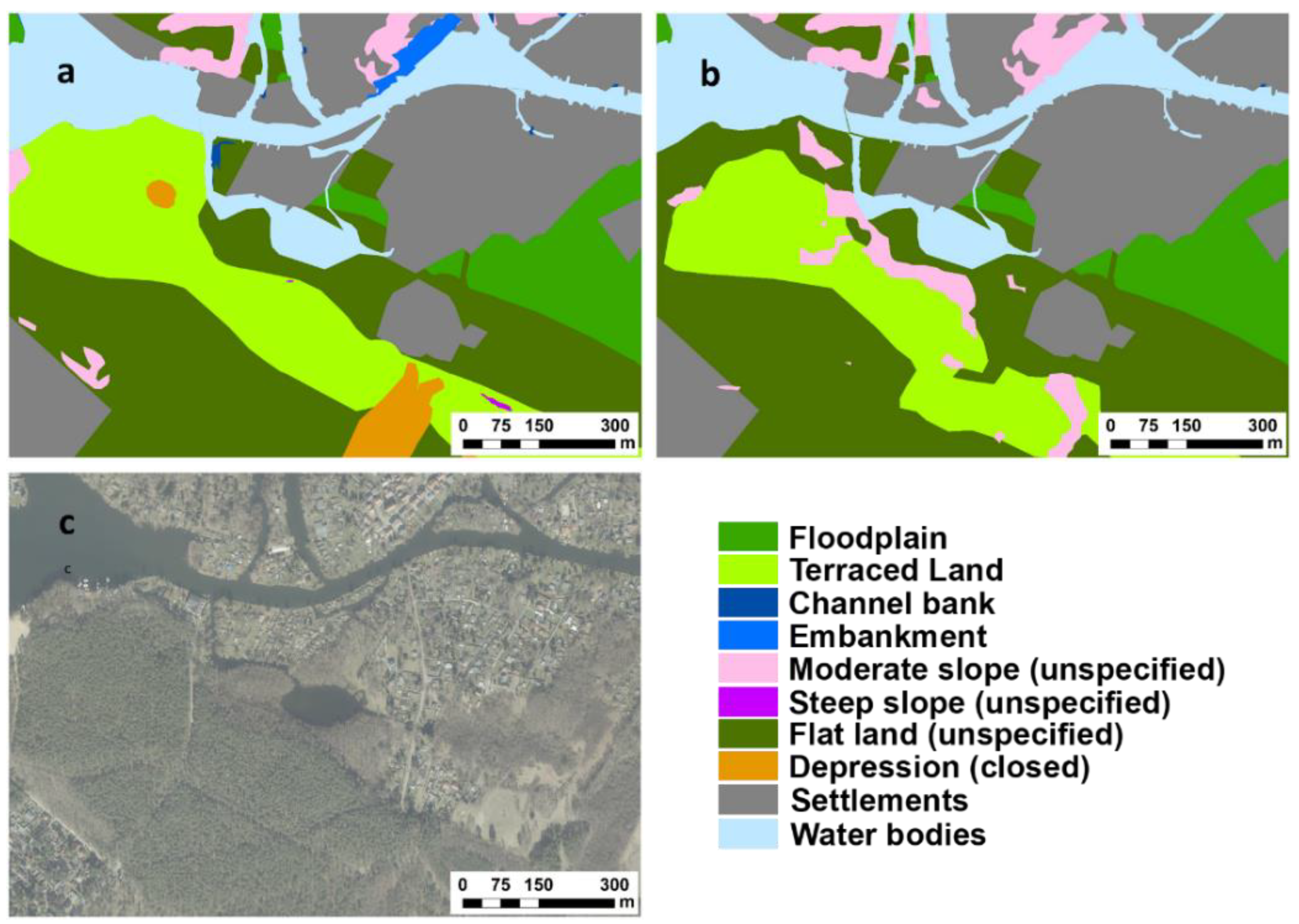
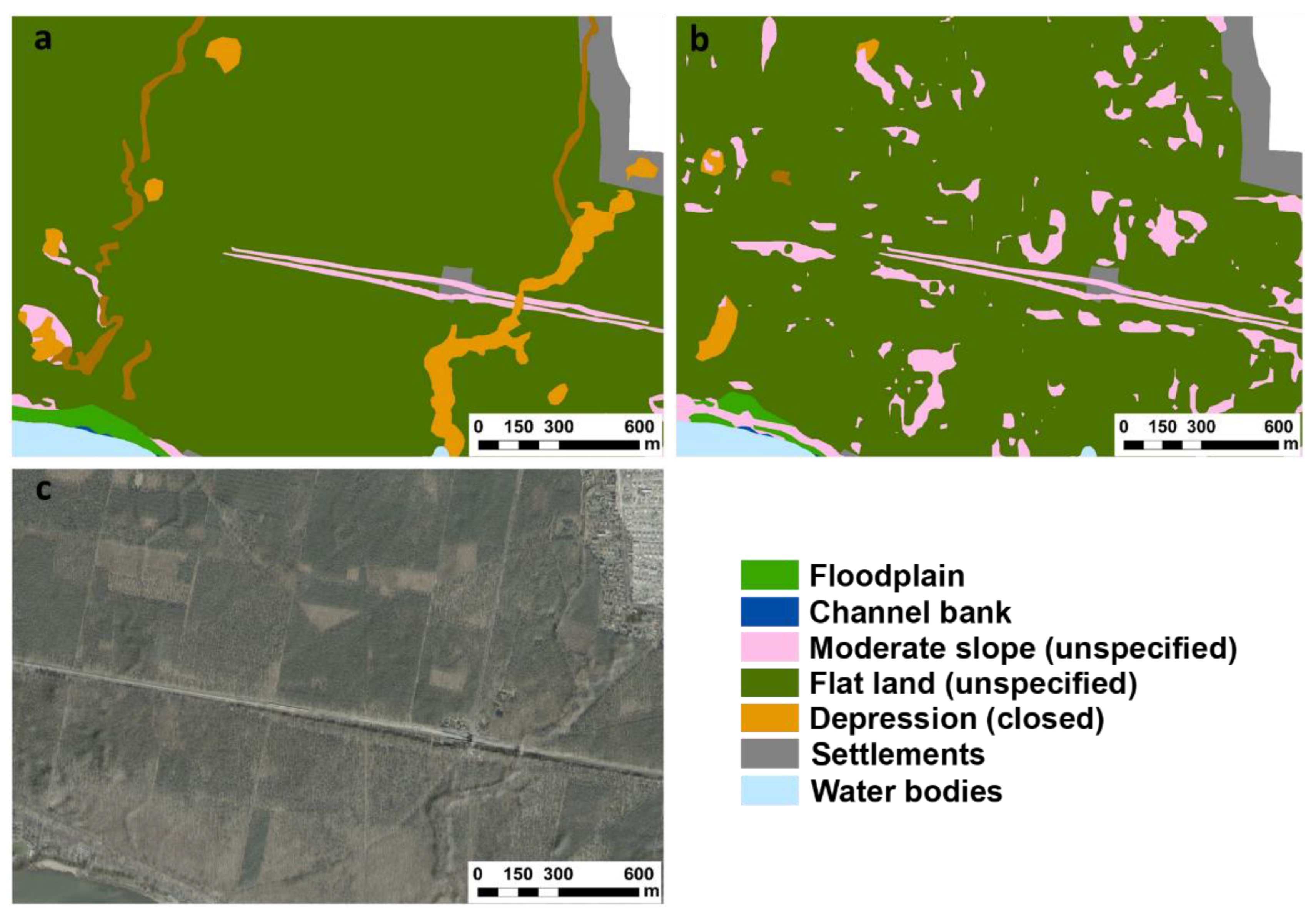
| Relief Structure | ID 1 | Predominant Soil Type | Typical Starting Substrate | (%) |
|---|---|---|---|---|
| Flood plain with alluvial dynamics (river flat) | 3030 | Gleysol, eutric Histosol (lower bog) | River sand | 2.06 |
| Ground moraines plateau | 2440 | Loose Lithosol (raw soils of loose material), Cambisol (brown soil), dystric Cambisol (rusty brown soils) | Loamy sand (glacial sands) | 0.81 |
| Sand dunes (dune landscape) | 1090 | Podzol | Fly-sand (wind-borne sand) on valley sand | 20.18 |
| 1100 1190 | Cambisol (brown soil) | |||
| 1060 | Dystric Cambisol (rusty brown soil), Regosol, Cambisol (colluvial brown soil), Gleysol | Loamy sand (glacial sands) | 0.75 | |
| Warsaw–Berlin glacial valley | 1160 | Dystric Cambisol (rusty brown soil) | Valley sand | 57.03 |
| 1164 | Cambisol (brown soil), Gleysol | |||
| 2487 | Calcaric Regosol, Loose Lithosol (raw soil of loose material) | |||
| 2483 | Regosol, Hortisol (horticultural soil) | |||
| 1260 | Eutric Histosol (lower bog) | Peat on valley sand | 12.23 | |
| Melt water channels | 1231 | Gleysol, Cambisol (brown soil) | Valley sand | 1.31 |
| Artificial structure (sand, industrial demolition, building rubble) | 2510 | Loose Lithosol (raw soils of loose material) | Rubble or accumulations of sand, industrial demolition, building rubble and backfilling | 2.25 |
| 2550 | Gleysol, Cambisol (brown soil), Hortisol (horticultural soil), alluvial soils | |||
| Push moraine/Landscape of sloping hill of loose material | 1040 | Dystric Cambisol (rusty brown soil), Regosol, Cambisol (brown soil) | Loamy sand (glacial sands), in places with embedded boulder loam (glacial loam) or marls | 2.76 |
| Dead ice sink/Small pond | 1250 | Dystric Cambisol (rusty brown soil), Gleysol, eutric Histosol (lower bog) | Valley sand, peat | 0.05 |
| Symbol | Geomorphometric Parameter | Software | Reference |
|---|---|---|---|
| LiDAR-DEM | Elevation | ArcGIS | [61] |
| ASTER-DEM | Elevation | ArcGIS | [62] |
| SLP | Slope | ArcGIS | [73] |
| ASP | Aspect | ArcGIS | [73] |
| PROFC | Profile curvature | ArcGIS | [74] |
| PLANC | Curvature surfaces or planar curvature | ArcGIS | [74] |
| CA | Catchment area | ArcGIS | [74] |
| VDCNmod | Modified vertical distance to channel network | SAGA-GIS | [6] |
| TWI | Compound topographic index (SAGA wetness index) | SAGA-GIS | [75] |
| STI | Sediment transport index | ArcGIS | [76,77] |
| GWD | Ground water depth | ArcGIS | [71] |
| FLOWA | Flow accumulation | ArcGIS | - |
| DISTWC | Distance to nearest watercourse | ArcGIS | - |
| HED | Hydrography Euclidian distance | ArcGIS | - |
| FM | Fuzzy membership function | ArcGIS | - |
| Landform | Relief Structure | Formation Process | Typical Starting Substrate | Properties |
|---|---|---|---|---|
| Crest | Dune | Aeolian, glacial | Fly-sand (wind-borne sand) | Low slope (1° < SLP < 3°), very low TWI |
| Hillside slope | Dunes, push moraine, ground moraines plateau, artificial landscape | Aeolian, glacial, human | Fly-sand (wind-borne sand), loamy sand (glacial sands), rubble or accumulations of sand, industrial demolition, building rubble and backfilling | Medium slope and high slope (SLP > 10°), very low TWI, high VDCN, specific CA, large std. dev. aspect |
| Flat land (unspecified) | Warsaw–Berlin glacial spillway | Glaciofluvial, fluvial | Valley sand, river sand | Low slope (SLP < 3°), medium TWI, low GWD |
| Depression (open, closed) | Dead ice sink, ground moraines plateau, melt water channels | Glacial, glaciofluvial | Valley sand, peat, loamy sand (glacial sands) | Low slope and medium slope (3° < SLP < 10°), high TWI, medium STI, medium and high GWD, low VDCN, low DISTWC |
| Embankment | Warsaw–Berlin glacial spillway, dune | Human | Sand, gravel, silt, clay | Medium slope and high slope (3 < SLP < 10°), medium TWI, medium GWD, close vicinity to fp ∩ tf U river |
| Terraced land | Warsaw–Berlin glacial spillway | Fluvial | Fluvial sediments (valley sand) | Medium slope (10° < SLP < 23°), very low TWI, high VDCN |
| Channel bank | Warsaw–Berlin glacial spillway | Fluvial | Fluvial sediments (valley sand) | Low slope and medium slope (1° < SLP < 10°), medium TWI, medium and high GWD, low DISTWC |
| Floodplain | Recent floodplain | Fluvial sediments (river sand with peat) | River sand with peat | Very low slope (SLP < 1°), very high TWI, medium STI, very high GWD, low VDCN, low DISTWC |
| Landform | Abbrev. | Description |
|---|---|---|
| Crest | cr | Landform element in the landscape that stands above all, or almost all, points in the adjacent terrain, with a positive plan and/or profile curvature |
| Moderate hillside slope | ms | Planar landform that is neither a crest nor a depression and has an inclination of 3–40%. |
| Steep hillside slope | ss | Planar landform that is neither a crest nor a depression and has an inclination >40% |
| Flat land (unspecified) | fl | Planar landform that is neither a crest nor a depression and is level or very gently inclined, with a slope < 3%. |
| Depression (open, closed) | de | Landform in the landscape that stands below all, or almost all, points in the adjacent terrain, with a negative plan and/or profile curvature, closed: local elevation minimum; open: extends at same or lower elevation |
| Embankment | eb | A bank (slope) is eroded and aggraded, and locally built up or excavated, by rarely active human agency, above the immediately surrounding land to redirect or prevent flooding by a river or lake, having an average slope > 1%. Embankments can be defined as narrow and elongated landforms that incline vertically towards the main slope direction, separating floodplains and river terraces or terraced land. |
| Terraced land | tl | Terraced land or terrace flats occur at stated heights above the top of the stream bank, including one or more terraces and often a flood plain. Relief is low < 35 m (elevation above major river level). |
| Channel bank | cb | Very short, very wide slope, moderately inclined to precipitous, forming the marginal upper parts of a stream channel and resulting from erosion or aggradation by channeled stream flow, resulting in changes of alignment, low < 35 m (elevation above major river level). |
| Floodplain | fp | Alluvial plain characterized by frequently active erosion and aggradation by channeled or overbank stream flow. Unless otherwise specified, ‘frequently active’ means that flow has an average recurrence interval of 50 years or less, having slope < 3%, low < 35 m (elevation above major river level). |
| Sample Points | Classification Based on Reference Data | |||||||||||
|---|---|---|---|---|---|---|---|---|---|---|---|---|
| Classification based on LiDAR-DEM | cr | ss | ms | fl | de | eb | tl | cb | fb | Total | UA (%) | |
| cr | 10 | 1 | 3 | 0 | 0 | 0 | 0 | 0 | 0 | 14 | 71.42 | |
| ss | 0 | 44 | 29 | 1 | 0 | 0 | 0 | 0 | 0 | 74 | 59.46 | |
| ms | 0 | 0 | 7639 | 620 | 0 | 46 | 91 | 21 | 0 | 8417 | 90.75 | |
| fl | 0 | 0 | 592 | 10,349 | 27 | 0 | 0 | 0 | 0 | 10,968 | 94.35 | |
| de | 0 | 0 | 0 | 0 | 78 | 0 | 0 | 0 | 0 | 78 | 100.00 | |
| eb | 0 | 0 | 0 | 0 | 0 | 54 | 0 | 3 | 0 | 57 | 94.73 | |
| tl | 0 | 0 | 12 | 8 | 0 | 0 | 71 | 0 | 5 | 96 | 73.95 | |
| cb | 0 | 0 | 6 | 0 | 0 | 0 | 0 | 147 | 0 | 153 | 96.07 | |
| fb | 0 | 0 | 0 | 4 | 0 | 0 | 0 | 0 | 79 | 83 | 95.18 | |
| Total | 10 | 45 | 8281 | 10,982 | 105 | 100 | 162 | 171 | 84 | 19,940 | ||
| PA (%) | 100 | 97.77 | 92.24 | 94.20 | 74.28 | 54.00 | 43.83 | 85.96 | 94.00 | |||
| Overall accuracy = 92.63% and kappa = 85.87%. | ||||||||||||
| Soil Type | Landform | ||||||||||
|---|---|---|---|---|---|---|---|---|---|---|---|
| ID 1 | cr | ss | ms | fl | de | eb | tl | cb | fb | ||
| Soils of mainly natural litho- and pedo-genesis | Dystric Cambisol (rusty brown soil), Regosol, Cambisol (brown soil) | 1040 | 0.00% | 0.00% | 4.32% | 0.00% | 0.00% | 8.77% | 0.00% | 3.23% | 0.00% |
| Dystric Cambisol (rusty brown soil), Regosol, Cambisol (colluvial brown soil), Gleysol | 1060 | 0.00% | 0.00% | 0.57% | 0.92% | 0.00% | 0.00% | 0.00% | 0.00% | 0.00% | |
| Podzol, Cambisol (brown soil) | 1090 1100 1190 | 0.00% | 44.59% | 38.51% | 0.50% | 3.85% | 0.00% | 94.00% | 3.27% | 0.00% | |
| Dystric Cambisol (rusty brown soil), Cambisol (brown soil), Gleysol | 1160 1164 | 0.00% | 0.00% | 28.82% | 67.02% | 38.46% | 64.92% | 6.00% | 13.73% | 0.00% | |
| Cambisol (brown soil), Gleysol | 1231 | 0.00% | 0.00% | 4.65% | 0.00% | 29.49% | 22.81% | 0.00% | 3.92% | 0.00% | |
| Dystric Cambisol (rusty brown soil), Gleysol, eutric Histosol (lower bog) | 1250 | 0.00% | 0.00% | 0.00% | 0.00% | 3.85% | 0.00% | 0.00% | 0.00% | 0.00% | |
| Eutric Histosol (lower bog) | 1260 | 0.00% | 0.00% | 12.44% | 7.66% | 3.84% | 1.75% | 0.00% | 71.90% | 88.31% | |
| Gleysol, eutric Histosol (lower bog) | 3030 | 0.00% | 0.00% | 0.00% | 17.01% | 0.00% | 0.00% | 0.00% | 3.92% | 11.69% | |
| Soils of anthropogenic litho- and pedogenesis | Loose Lithosol (raw soils of loose material), Gleysol | 2430 | 0.00% | 10.81% | 0.00% | 0.00% | 0.00% | 0.00% | 0.00% | 0.00% | 0.00% |
| Loose Lithosol (raw soils of loose material), Cambisol (brown soil), dystric Cambisol (rusty brown soils) | 2440 | 0.00% | 4.41% | 3.77% | 0.00% | 11.54% | 0.00% | 0.00% | 0.00% | 0.00% | |
| Hortisol (horticultural soil) | 2483 | 0.00% | 0.00% | 0.00% | 0.00% | 2.56% | 1.75% | 0.00% | 0.00% | 0.00% | |
| Calcaric Regosol, loose Lithosol (raw soil of loose material), Regosol | 2487 | 0.00% | 18.92% | 4.98% | 0.00% | 0.00% | 0.00% | 0.00% | 0.00% | 0.00% | |
| Loose Lithosol (raw soils of loose material) | 2510 | 100% | 20.27% | 1.94% | 0.00% | 0.00% | 0.00% | 0.00% | 0.00% | 0.00% | |
| Gleysol, Cambisol (brown soil), Hortisol (horticultural soil), alluvial soils | 2550 | 0.00% | 0.00% | 0.00% | 0.00% | 6.41% | 0.00% | 0.00% | 0.00% | 0.00% | |
| Sample Points | Classification Based on Reference Data | |||||||||||
|---|---|---|---|---|---|---|---|---|---|---|---|---|
| Classification based on ASTER-DEM | cr | ss | ms | fl | de | eb | tl | cb | fb | Total | UA (%) | |
| cr | 4 | 0 | 0 | 0 | 0 | 0 | 0 | 0 | 0 | 4 | 100.00 | |
| ss | 0 | 22 | 0 | 0 | 0 | 0 | 0 | 0 | 0 | 22 | 100.00 | |
| ms | 6 | 46 | 3876 | 817 | 0 | 58 | 59 | 31 | 0 | 4893 | 79.21 | |
| fl | 0 | 0 | 4405 | 9143 | 334 | 0 | 4 | 0 | 0 | 13,886 | 65.84 | |
| de | 0 | 0 | 0 | 138 | 92 | 0 | 0 | 0 | 0 | 230 | 40.00 | |
| eb | 0 | 0 | 0 | 0 | 0 | 32 | 00 | 4 | 0 | 36 | 88.88 | |
| tl | 0 | 0 | 0 | 37 | 0 | 0 | 92 | 0 | 55 | 184 | 50.00 | |
| cb | 0 | 0 | 0 | 0 | 0 | 0 | 0 | 16 | 0 | 16 | 100.00 | |
| fb | 0 | 0 | 0 | 85 | 2 | 0 | 0 | 0 | 582 | 669 | 86.99 | |
| Total | 10 | 68 | 8281 | 10,220 | 428 | 90 | 155 | 51 | 637 | 19,940 | ||
| PA (%) | 40.00 | 32.35 | 46.80 | 89.46 | 21.49 | 35.35 | 38.06 | 31.37 | 91.36 | |||
| Overall accuracy = 69.50% and kappa = 43.59%. | ||||||||||||
| Category | Classification Based on LiDAR-DEM | Classification Based on ASTER-DEM | ||||||
|---|---|---|---|---|---|---|---|---|
| Sample Points | Total of Sample Points | Correlation | Area (%) | Sample points | Total of Sample Points | Correlation | Area (%) | |
| cr | 10 | 14 | 71.20% | 0.02 | 4 | 4 | 70.10% | 0.03 |
| ss | 44 | 74 | 59.40% | 0.21 | 22 | 22 | 59.10% | 0.04 |
| ms | 7639 | 8417 | 90.6% | 8.53 | 3876 | 4893 | 73.00% | 8.65 |
| fl | 10,349 | 10,968 | 94.20% | 70.23 | 9143 | 13,886 | 75.50% | 71.01 |
| de | 78 | 78 | 98.30% | 5.28 | 92 | 230 | 40.00% | 1.72 |
| eb | 54 | 57 | 83.50% | 0.29 | 32 | 36 | 28.30% | 0.15 |
| tl | 71 | 96 | 58.50% | 0.83 | 92 | 184 | 34.30% | 1.45 |
| cb | 147 | 153 | 73.00% | 0.17 | 16 | 16 | 17.02% | 0.10 |
| fb | 79 | 83 | 95.30% | 14.44 | 582 | 669 | 86.90% | 16.85 |
| Total | 18,471 | 19,940 | 82.10% | 100 | 13,859 | 19,940 | 55.65% | |
| Overall correlation = 68.88% | ||||||||
© 2020 by the author. Licensee MDPI, Basel, Switzerland. This article is an open access article distributed under the terms and conditions of the Creative Commons Attribution (CC BY) license (http://creativecommons.org/licenses/by/4.0/).
Share and Cite
Mohamed, M.A. Classification of Landforms for Digital Soil Mapping in Urban Areas Using LiDAR Data Derived Terrain Attributes: A Case Study from Berlin, Germany. Land 2020, 9, 319. https://doi.org/10.3390/land9090319
Mohamed MA. Classification of Landforms for Digital Soil Mapping in Urban Areas Using LiDAR Data Derived Terrain Attributes: A Case Study from Berlin, Germany. Land. 2020; 9(9):319. https://doi.org/10.3390/land9090319
Chicago/Turabian StyleMohamed, Mohamed Ali. 2020. "Classification of Landforms for Digital Soil Mapping in Urban Areas Using LiDAR Data Derived Terrain Attributes: A Case Study from Berlin, Germany" Land 9, no. 9: 319. https://doi.org/10.3390/land9090319
APA StyleMohamed, M. A. (2020). Classification of Landforms for Digital Soil Mapping in Urban Areas Using LiDAR Data Derived Terrain Attributes: A Case Study from Berlin, Germany. Land, 9(9), 319. https://doi.org/10.3390/land9090319





